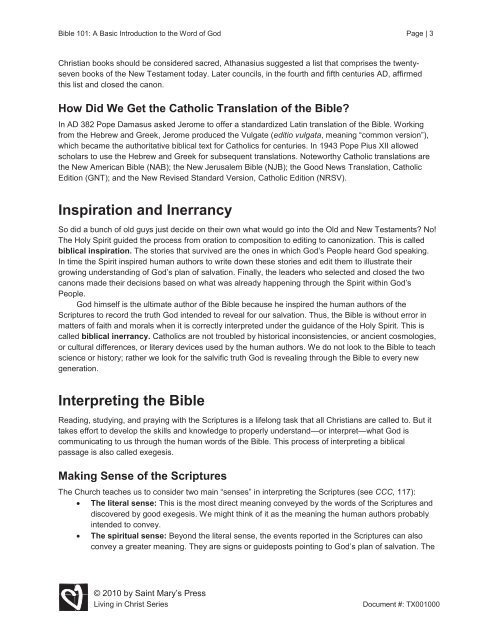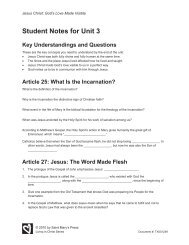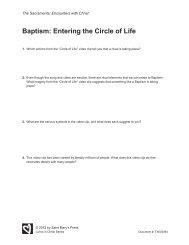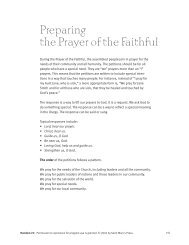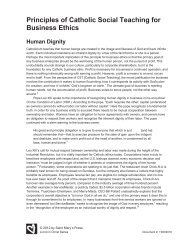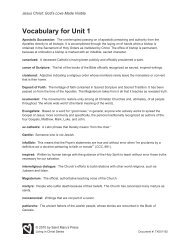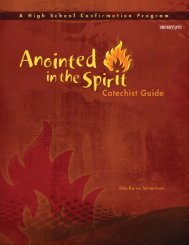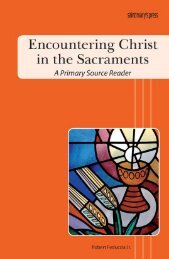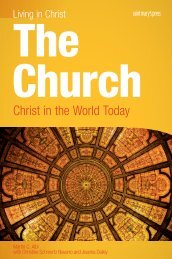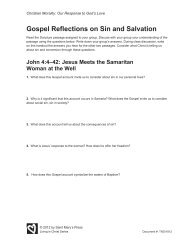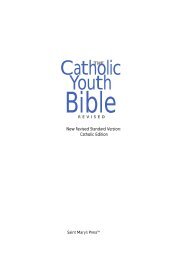Bible 101: A Basic Introduction to the Word of God - Saint Mary's Press
Bible 101: A Basic Introduction to the Word of God - Saint Mary's Press
Bible 101: A Basic Introduction to the Word of God - Saint Mary's Press
You also want an ePaper? Increase the reach of your titles
YUMPU automatically turns print PDFs into web optimized ePapers that Google loves.
<strong>Bible</strong> <strong>101</strong>: A <strong>Basic</strong> <strong>Introduction</strong> <strong>to</strong> <strong>the</strong> <strong>Word</strong> <strong>of</strong> <strong>God</strong> Page | 3Christian books should be considered sacred, Athanasius suggested a list that comprises <strong>the</strong> twentysevenbooks <strong>of</strong> <strong>the</strong> New Testament <strong>to</strong>day. Later councils, in <strong>the</strong> fourth and fifth centuries AD, affirmedthis list and closed <strong>the</strong> canon.How Did We Get <strong>the</strong> Catholic Translation <strong>of</strong> <strong>the</strong> <strong>Bible</strong>?In AD 382 Pope Damasus asked Jerome <strong>to</strong> <strong>of</strong>fer a standardized Latin translation <strong>of</strong> <strong>the</strong> <strong>Bible</strong>. Workingfrom <strong>the</strong> Hebrew and Greek, Jerome produced <strong>the</strong> Vulgate (editio vulgata, meaning “common version”),which became <strong>the</strong> authoritative biblical text for Catholics for centuries. In 1943 Pope Pius XII allowedscholars <strong>to</strong> use <strong>the</strong> Hebrew and Greek for subsequent translations. Noteworthy Catholic translations are<strong>the</strong> New American <strong>Bible</strong> (NAB); <strong>the</strong> New Jerusalem <strong>Bible</strong> (NJB); <strong>the</strong> Good News Translation, CatholicEdition (GNT); and <strong>the</strong> New Revised Standard Version, Catholic Edition (NRSV).Inspiration and InerrancySo did a bunch <strong>of</strong> old guys just decide on <strong>the</strong>ir own what would go in<strong>to</strong> <strong>the</strong> Old and New Testaments? No!The Holy Spirit guided <strong>the</strong> process from oration <strong>to</strong> composition <strong>to</strong> editing <strong>to</strong> canonization. This is calledbiblical inspiration. The s<strong>to</strong>ries that survived are <strong>the</strong> ones in which <strong>God</strong>’s People heard <strong>God</strong> speaking.In time <strong>the</strong> Spirit inspired human authors <strong>to</strong> write down <strong>the</strong>se s<strong>to</strong>ries and edit <strong>the</strong>m <strong>to</strong> illustrate <strong>the</strong>irgrowing understanding <strong>of</strong> <strong>God</strong>’s plan <strong>of</strong> salvation. Finally, <strong>the</strong> leaders who selected and closed <strong>the</strong> twocanons made <strong>the</strong>ir decisions based on what was already happening through <strong>the</strong> Spirit within <strong>God</strong>’sPeople.<strong>God</strong> himself is <strong>the</strong> ultimate author <strong>of</strong> <strong>the</strong> <strong>Bible</strong> because he inspired <strong>the</strong> human authors <strong>of</strong> <strong>the</strong>Scriptures <strong>to</strong> record <strong>the</strong> truth <strong>God</strong> intended <strong>to</strong> reveal for our salvation. Thus, <strong>the</strong> <strong>Bible</strong> is without error inmatters <strong>of</strong> faith and morals when it is correctly interpreted under <strong>the</strong> guidance <strong>of</strong> <strong>the</strong> Holy Spirit. This iscalled biblical inerrancy. Catholics are not troubled by his<strong>to</strong>rical inconsistencies, or ancient cosmologies,or cultural differences, or literary devices used by <strong>the</strong> human authors. We do not look <strong>to</strong> <strong>the</strong> <strong>Bible</strong> <strong>to</strong> teachscience or his<strong>to</strong>ry; ra<strong>the</strong>r we look for <strong>the</strong> salvific truth <strong>God</strong> is revealing through <strong>the</strong> <strong>Bible</strong> <strong>to</strong> every newgeneration.Interpreting <strong>the</strong> <strong>Bible</strong>Reading, studying, and praying with <strong>the</strong> Scriptures is a lifelong task that all Christians are called <strong>to</strong>. But ittakes effort <strong>to</strong> develop <strong>the</strong> skills and knowledge <strong>to</strong> properly understand—or interpret—what <strong>God</strong> iscommunicating <strong>to</strong> us through <strong>the</strong> human words <strong>of</strong> <strong>the</strong> <strong>Bible</strong>. This process <strong>of</strong> interpreting a biblicalpassage is also called exegesis.Making Sense <strong>of</strong> <strong>the</strong> ScripturesThe Church teaches us <strong>to</strong> consider two main “senses” in interpreting <strong>the</strong> Scriptures (see CCC, 117): The literal sense: This is <strong>the</strong> most direct meaning conveyed by <strong>the</strong> words <strong>of</strong> <strong>the</strong> Scriptures anddiscovered by good exegesis. We might think <strong>of</strong> it as <strong>the</strong> meaning <strong>the</strong> human authors probablyintended <strong>to</strong> convey. The spiritual sense: Beyond <strong>the</strong> literal sense, <strong>the</strong> events reported in <strong>the</strong> Scriptures can alsoconvey a greater meaning. They are signs or guideposts pointing <strong>to</strong> <strong>God</strong>’s plan <strong>of</strong> salvation. The© 2010 by <strong>Saint</strong> Mary’s <strong>Press</strong>Living in Christ SeriesDocument #: TX001000


